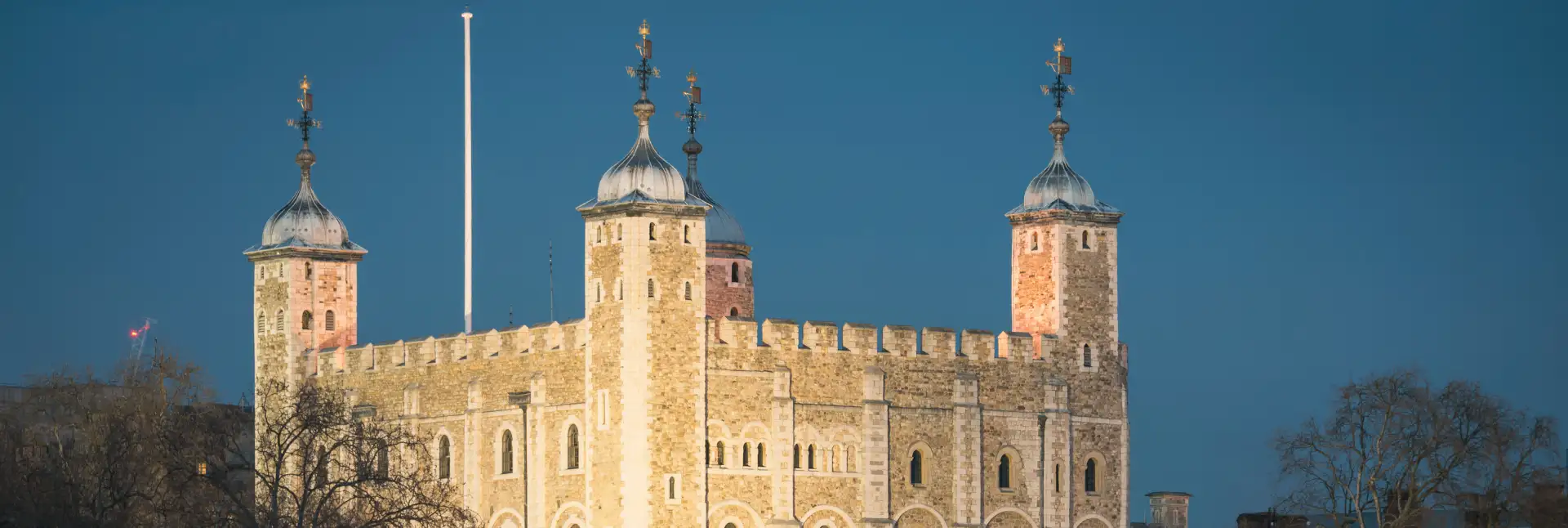
What is the history of the Tower of London?
The history of the Tower of London is filled with betrayals, coronations, disappearances, executions, and state secrets. Every one of its stones has witnessed centuries of power, fear, and ambition, and before you buy your tickets to the Tower of London, let us tell you everything its walls have seen. Step into its halls and passageways and discover the light and shadows of this fascinating monument.
Years 1066–1078: the birth of the White Tower
The story of the Tower of London begins after the Norman conquest of England. In 1066, William the Conqueror defeated Harold II at the Battle of Hastings and was crowned King of England. Aware that his power needed to be consolidated in such a strategic city as London, he ordered the construction of an imposing fortress on the north bank of the River Thames.
Thus, around the year 1078, construction began on what we now know as the White Tower. This central core of the tower was built from limestone brought from Caen, in Normandy, symbolizing Norman power over the Anglo-Saxons. It was so imposing and sturdy that it intimidated Londoners and, over time, became the heart of the entire fortified complex.
12th Century: expansion and fortification under the Plantagenets
In 1097, William II “Rufus”, son of the Conqueror, decided to expand the tower. A defensive wall was built around the compound, and a moat was added to enhance its protection. These measures responded to both external threats and internal tensions within the kingdom, which were often the most dangerous.
By the end of the 12th century, during the reign of Richard the Lionheart (1189–1199), the defenses were further strengthened. Although the king spent most of his reign on the Crusades, he left instructions to reinforce the tower. Additionally, the Jewel House was built, a building intended to protect the Crown Jewels, a tradition that continues to this day.
1200–1300: revolts, royal losses, and new structures
The 13th century was a time of instability. During the escape of King John of England, also known as John Lackland, from a rebellion in 1216, it is said that he lost the Crown Jewels in the marshes of the Thames. The loss was seen as a sign of the monarch’s weakness, and his reign ended in disaster.
Later, King Edward I undertook a major expansion of the complex. A new royal entrance, the Wakefield Tower, was constructed, and the St. Thomas’s Tower was added to control river access. This ensemble formed part of a more complete wall, which can still be seen today.
In 1381, during the Peasants’ Revolt, the insurgents managed to enter the tower. In a symbolic and brutal act, the Archbishop of Canterbury, Simon Sudbury, was beheaded inside. This event showed that not even the strongest walls could contain the discontent of the people.
1400–1500: betrayals, disappearances, and executions
Throughout the 15th and 16th centuries, the history of the Tower of London became the scene of one of the darkest episodes in English history. In 1483, Richard III imprisoned his nephews, Princes Edward and Richard, rightful heirs to the throne and known thereafter as “The Princes in the Tower.” Nothing was ever heard from the young princes, aged 12 and 9 respectively, though everyone assumed they were murdered on their uncle’s orders.
During the Tudor reign, especially under Henry VIII, the tower became a place feared by the nobility. Anne Boleyn, the monarch’s second wife, was executed in 1536 after being accused of adultery and treason. Other wives and nobles such as Catherine Howard, Thomas More, and Thomas Cromwell were also executed. Fear of being imprisoned within the tower’s walls was well-founded: few left alive.
17th Century: torture, plots, and a royal zoo
It may seem odd that in the history of the Tower of London the words “torture, plots, and zoo” go together, but such is the nature of this colorful place. In 1605, Guy Fawkes and his co-conspirators were imprisoned and tortured in the tower following the failed Gunpowder Plot, which aimed to blow up Parliament and assassinate King James I. The tower continued to be used as a prison for enemies of the state, but it also began to serve other purposes.
During the English Civil War (1642–1651), it was again used as a military prison. However, between 1660 and 1688, under the reign of Charles II, the tower housed a peculiar attraction: it became a royal zoo, with lions, bears, and exotic birds displayed as symbols of the Crown’s power and exoticism.
19th Century: restoration and transformation into a national symbol
From 1800 onwards, the Royal Mint was relocated outside the tower, allowing for its historical restoration. During the 19th century, major works were carried out to restore its medieval appearance and turn it into a symbol of England’s glorious past.
The works, led by architect Anthony Salvin and other restorers, focused on rebuilding towers, cleaning structures, and preserving historic spaces, creating the image we know today. The tower became more of a national monument than an active fortress.
1988: recognition as a World Heritage Site
In 1988, UNESCO officially recognized the Tower of London as a World Heritage Site, highlighting its architectural and historical value. Since then, millions of visitors have walked through its halls, towers, and courtyards each year, fascinated by the wealth of stories each corner holds.
Today, it remains the ceremonial residence of the Yeoman Warders (the famous Beefeaters), houses the Crown Jewels, and is one of the most visited and treasured tourist sites in the entire United Kingdom.
If you too want to discover firsthand the stories of conquest, power, and betrayal of this fantastic monument, with our tickets to the Tower of London you can do so in the best way — book your day and don’t miss out!